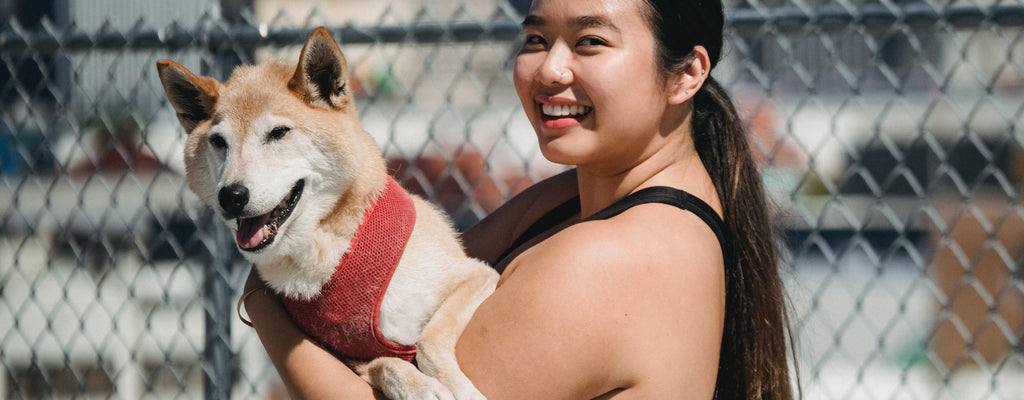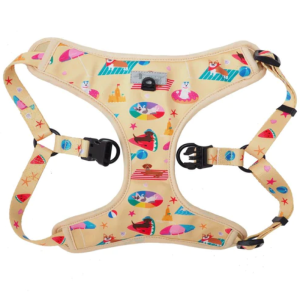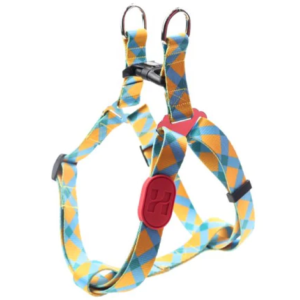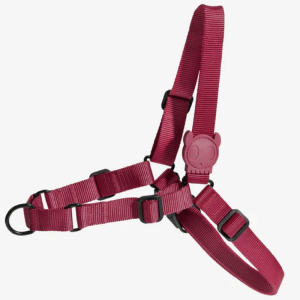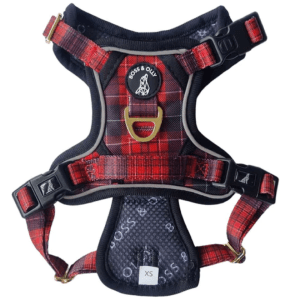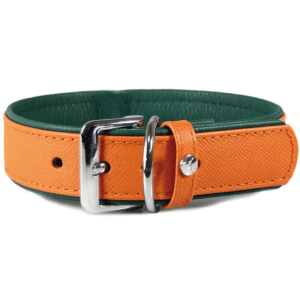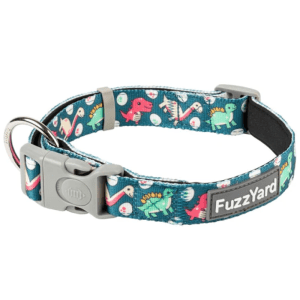Whether you are trying to train your dog or simply want to walk them, dog collars & dog harnesses are essential for every dog owner to have. It is especially important to choose the right harness and collar as it can make all the difference!
There are many different styles of both items — some are great, some not so much. In this article, we shall discuss the benefits of using a dog harness and collar, as well as share what are the best dog collars & harnesses for 2023!
What is a Dog Harness?

Unlike a dog collar, a dog harness wraps around a dog’s torso, fitting comfortably under your dog’s chest and over its back. Most dog owners switch from collars to harnesses because they are worried that a collar may hurt their dog’s throat.
This is especially if their dog tends to pull on the leash! Dogs can also escape from collars if they are too loose. Furthermore, harnesses can make it easier to transport dogs with health issues, such as disabilities.
Which is Better: Collars or Harnesses?

Most vets will tell you that they recommend a harness over a collar when it comes to walking dogs. Dog collars can sometimes lead to issues such as choking or collapsed tracheas.
Here are some of the reasons stated by veterinarians as to why they prefer dog harnesses over dog collars:
- Harnesses can help prevent neck or throat injury for puppies or dogs who tend to pull or tug on their leash.
- Dogs can escape more easily from a collar than a harness. If your dog has a tendency to slip out of his/her collar, a harness could literally save their life.
- Harnesses are especially ideal for flat-faced or brachycephalic breed dogs, such as Frenchies or Pugs. Dog collars tend to put pressure on their necks, which can make it harder for them to breathe.
- Most dogs will generally find harnesses to be more comfortable than dog collars.
- A harness will prevent the leash from getting caught under or wrapped around your dog’s legs, if the leash is attached to the back of the harness.
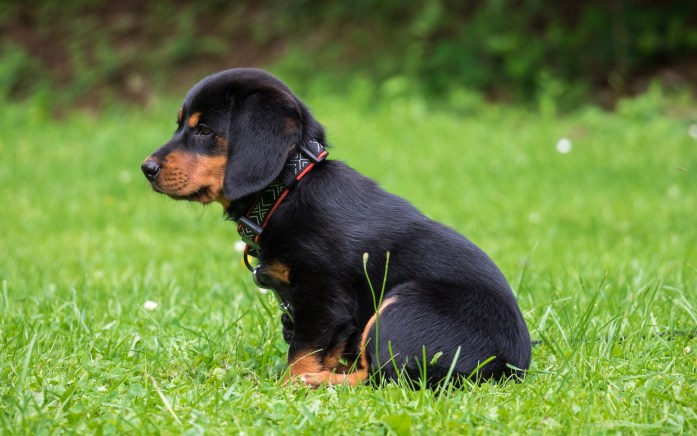
However, a lot of dog trainers recommend that you use a collar to start training your dog how to walk on a leash. Here are more reasons why you should consider using a collar:
- Collars are generally easier to put on and take off than most harnesses.
- Dogs are usually much easier to manage when walking on a leash with a collar as they can provide better control.
- A collar may discourage your dog from pulling as you are able to redirect them with more ease.
- Dog collars can sometimes be more comfortable than harnesses in warm weather, depending on the design and material.
When to Use A Dog Harness

Harnesses are used most for walking but can also be used for travel and assistance with injured, ill or disabled animals. Additionally, here are some situations in which a harness is more beneficial than a collar:
- Older dogs who were not properly leash trained and need to learn how to walk properly on a leash for safety reasons.
- Dogs that have a stubborn streak and need to learn how to walk on a leash.
- Puppies that are being trained on how to walk with a leash.
Types of Dog Harnesses
Traditional Strap Dog Harness
The classic dog harness is typically constructed from nylon straps. It also has sturdy plastic or stainless steel hardware, including an attachment at the back for the leash to clip to.
Soft Vest Dog Harness
If you are looking for comfort, a soft or padded vest harness is the way to go. The material tends to be neoprene or polyester, and wouldn’t chafe as much as other dog harnesses might. It usually also has a breathable mesh, making it suitable for dogs in Singapore.
Back Clip Dog Harness
This style of harness is perhaps the most common. The leash will attach on the back of the dog instead of the front. It comes in many different variations!
Front Clip Dog Harness
Being able to clip your leash to the front of your dog’s harness can help you guide them better. Some variations of such harnesses are designed for training your dog to walk on a leash and can even be tightened!
Dual Clip Dog Harness
This style of harness is becoming more popular; it has an attachment at the front and back for you to attach a leash to. It also allows you the option of attaching a leash to the front, back, or even both!
Special Lift or Sling Harness for Disabled Dogs
:This type of dog harness is ideal for those dogs with mobility issues. Typically, this type of harness will fit around the midsection of your dog. It will also have a handle so you can safely and easily lift your dog. This is especially helpful when your dog needs to get in and out of a vehicle, or up or down stairs as needed. Other harnesses like the Ruffwear Web Master Secure Multi-Function Handled Dog Harness however are also suitable.
Tips for Buying Dog Harnesses

- Consider the safety factor: Safety is the most important thing when it comes to dog harnesses. Every type of harness is designed differently. Do also note that the type of harness you need for your small pooch is different from what your neighbor needs for their large breed dog. It would be wise to invest in a harness that is durable and will last for some time.
- Style: In this reference, style does not refer to type of harness. Rather, it refers to style as in the fashion sense. What you might find stylish and trendy, might not be right for your dog. Remember you are buying the harness for your dog, not for yourself. What matters the most is choosing the most comfortable and secure harness for your dog.
- Cost: While you might want to find the least expensive harness possible, keep in mind that quality is more important than cost. You want a harness that is safe, comfortable and sturdy! Consider it an investment in your dog’s happiness and overall safety.
- Fit: Keep in mind that your dog may be built differently than others, so you should always purchase a harness based on his/her measurements. If the harness is too loose, your dog can wriggle its way out. Conversely, a harness that is too tight can be uncomfortable, or worse, hurting your dog and causing damage to their back, chest or throat. Remember to measure twice and write down the measurements before buying the harness. Pay attention to size charts when browsing for a suitable dog harness and read reviews if possible.
Safety Tips for Dog Harnesses

- Always inspect the fit before walking: It is imperative to ensure that the harness is secure yet not too tight (or too loose). The best way to check if the harness is properly fitted, is to use the “two-finger method”. This is where you place two fingers snugly between your dog and the harness. Anything less is too tight, while anything more is not secure enough.
- Take off the harness if it gets wet: Like wet clothes are uncomfortable for us, wet collars, clothes and harnesses are also uncomfortable for our dogs. More importantly, the fabric on the harness can cause chafing, which can lead to a skin infection.
- Remove the harness when at home: It is not ideal to leave the harness on your dog, especially when sleeping. There is also always the risk that the harness can get caught on something, which can lead to serious injury. Moreover, some dogs may tend to chew on their harness if stressed, which will not only damage the harness, but can also become a choking hazard or harmful if ingested.
Advice for Getting Your Dog Used to A Dog Harness

You should not just try to strap the harness on your dog and take them for a walk without first getting them used to the idea of a harness. Remember, the harness may seem terrifying to them. It is best to get them used to the idea of a harness gradually.
Simply putting on the harness and immediately taking your dog for a walk may traumatize them. Furthermore, they may injure themselves if they panic and try to take it off. In the worst-case scenario, it can put them off using a harness ever again in the future.
First, show the dog your harness and allow them to sniff it. Scent is important to dogs and they need to become familiar with any new scent. Slowly get your dog used to it by putting on the harness for a bit at home and then rewarding them with a treat, affection or play time.
Once your dog feels comfortable in the harness, take it on and off several times in a row. This allows them to get used to the feel and sound of the harness. Praise them each time they let you put it on and take it off successfully. You can then attach the leash and start moving with them slowly.
Talk to them in a gentle, calm and soothing voice, praising them for acceptable behavior. Once you are certain they are comfortable with the harness, you can take them on short walks, gradually increasing the length of the walk each time.
Types of Dog Collars
Flat Collar
The standard type of collar is the flat collar and probably the most popular. However, one must keep in mind that there is a chance your dog’s throat might suffer an injury if he pulls too hard on his leash while walking.
Martingale Collar
This type of collar is commonly used by Greyhound & Whippet owners as they have tapered heads and can slip out of a flat collar easily. Martingale collars are specifically designed to help train dogs not to pull on the leash. They are also great at giving you more control when walking your dog without hurting them. It basically tightens (to a certain extent) when the dog pulls, and goes back to its normal length when they stop.
Slip Collar
Unlike martingale collars, slip collars do not have a limit on how much they can tighten. This can be dangerous, especially when used by an untrained individual. Dog trainers sometimes use it in more extreme cases where the dogs have behavioral issues, such as being overly reactive, and need correction.S
Smart Collar
These high tech collars are equipped with the latest technologies such as a GPS tracking device and behaviour monitoring. Most of these collars work with smartphone apps and can help you keep track of your dog’s location, activity levels and more! You can also attach tracking devices, such as AirTag to your dog’s collar using a special holder.
Head Collar
This type of collar is similar to a muzzle in design, However, it is more of a halter type collar that is basically a head harness that is intended to teach dogs simple commands like “heel” and how to properly walk on a leash. When properly used by the handler, head collars will discourage dogs from pulling. However, this type of collar should not be used with a long lead nor left on the dog while unattended.
Pinch or Prong Collar

This style of collar was once very popular among dog trainers, especially on large untrained dogs. It is now deemed as dangerous by many experts and animal welfare advocates. Some of these collars can be very painful, and can even leave hole-shaped wounds in your dog’s neck.
Word of Caution about Retractable Leashes
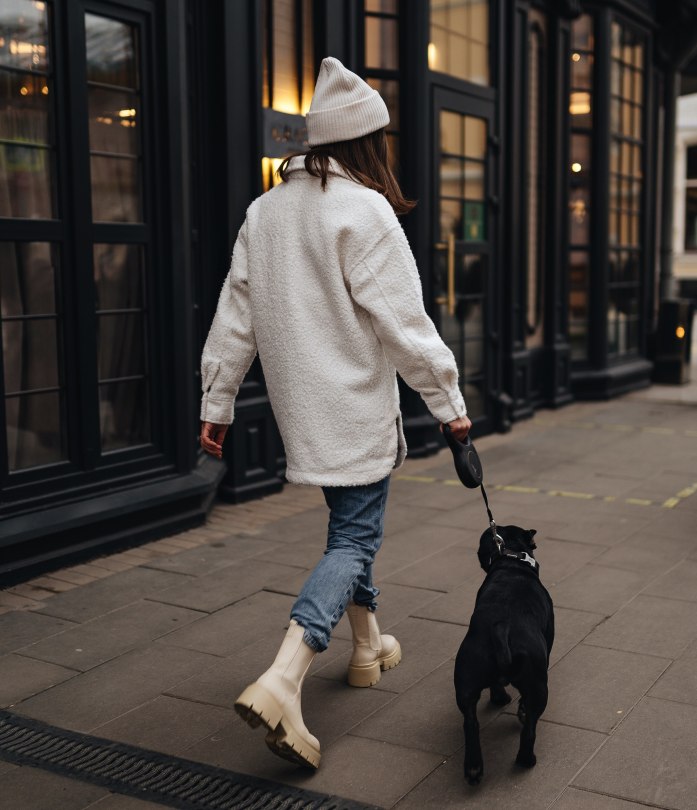
While this article is meant to focus on the different types of dog collars and harnesses, we feel it is extremely important to remind our readers of the dangers of retractable leashes. Retractable leashes can be harmful to both dogs and their owners.
Here are a few of the dangers of retractable leashes:
- The cord is thin and can break easily.
- The cord is a tripping hazard and can become wrapped around the owner’s legs, which can also lead to burns and cuts or worst case scenarios, such as choking or amputation.
- You could accidentally break your dog’s neck if you pull back too hard on a retractable leash.
- Retractable leashes can malfunction, or you could lose control. This is especially dangerous in high traffic areas, or if your dog is approached by an aggressive dog.
Most veterinarians, dog behaviorists and other experts strongly advise dog owners to avoid retractable leashes at all costs.
Overall, both dog collars and harnesses have pros as well as cons. However, every dog is different and your dog may feel more comfortable with one or the other. The key is to get the right size and fit in the most comfortable and durable material possible.
Talk with your vet if you need recommendations or have concerns about either of the two. And as always, pay close attention to your dog’s behaviour when walking your dog. Their safety is of utmost importance at all times!
